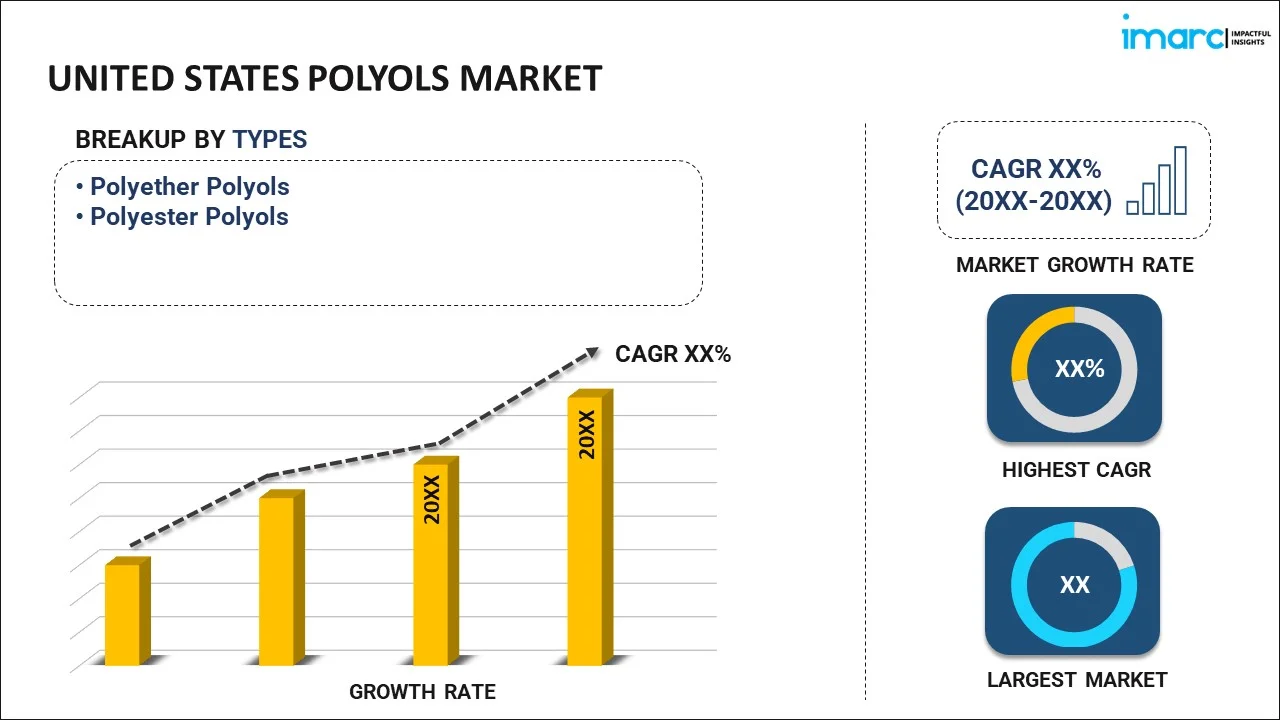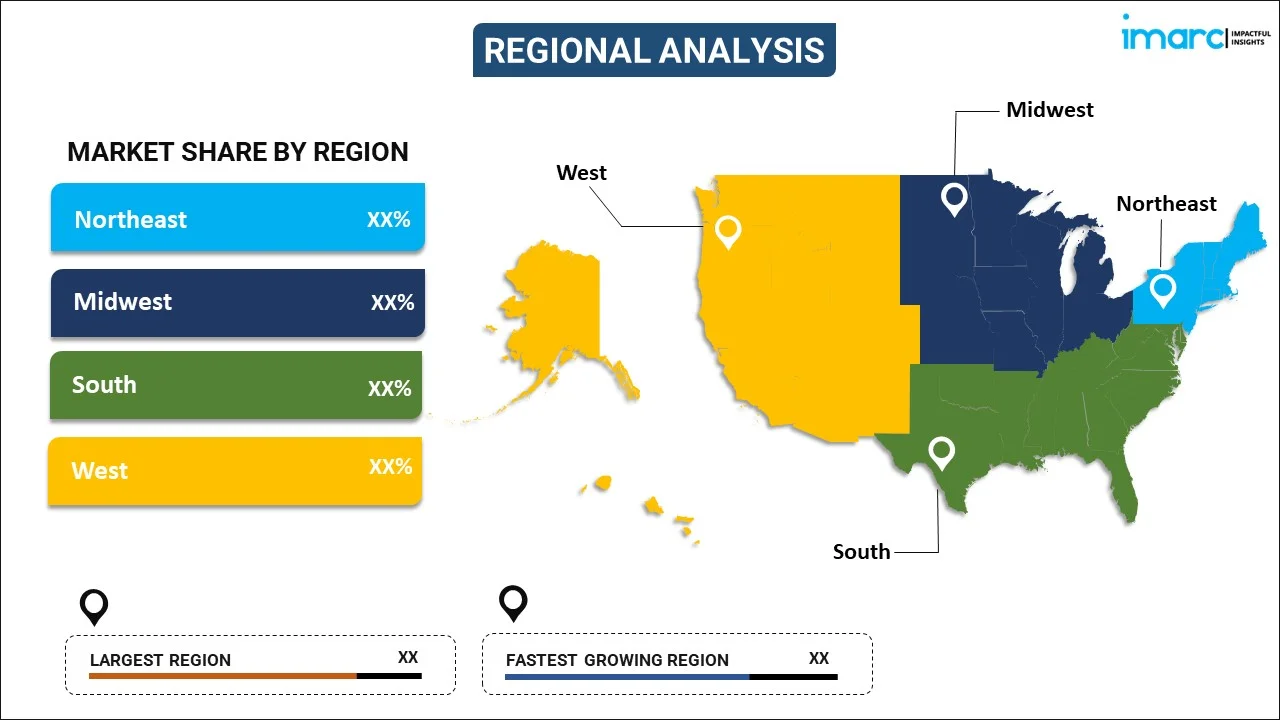
United States Polyols Market Report by Type (Polyether Polyols, Polyester Polyols), Application (Flexible Polyurethane Foams, Rigid Polyurethane Foams, CASE (Coatings, Adhesives, Sealants & Elastomers), and Others), Industry (Carpet Backing, Packaging, Furniture, Automotive, Building & Construction, Electronics, Footwear, and Others), and Region 2025-2033
Market Overview:
The United States polyols market size reached USD 1.22 Billion in 2024. Looking forward, IMARC Group expects the market to reach USD 1.44 Billion by 2033, exhibiting a growth rate (CAGR) of 1.82% during 2025-2033. The market is driven by the rising demand for energy-efficient insulation materials in the construction industry, growing consumer preference for low-calorie and sugar-free food products, and a strong industry shift toward sustainable, bio-based polyol alternatives. The construction sector values polyols for their role in high-performance polyurethane insulation, while food and pharmaceutical industries use polyols as functional sweeteners. Simultaneously, environmental regulations and sustainability goals are accelerating innovation in green chemistry, making eco-friendly polyols increasingly attractive across multiple applications.
|
Report Attribute
|
Key Statistics
|
|---|---|
|
Base Year
|
2024
|
|
Forecast Years
|
2025-2033
|
|
Historical Years
|
2019-2024
|
|
Market Size in 2024
|
USD 1.22 Billion |
|
Market Forecast in 2033
|
USD 1.44 Billion |
| Market Growth Rate (2025-2033) | 1.82% |
Polyols are a group of organic compounds made up of different hydroxyl groups. Also known as sugar alcohols, polyols contain versatile carbohydrates with low calories and an identical taste and texture to table sugar. They are extensively utilized in the food and beverage industry as a sugar replacement in products like candies, chewing gums, ice creams, yogurts, and fruit spreads is aiding the United States polyols market demands. Polyols are also employed in toothpaste, mouthwash, throat lozenges, and breath mints. In the chemical industry, they have applicability in the production of flexible and rigid polyurethane coatings, foams, sealants, elastomers and adhesives.
The United States represents one of the largest markets for polyols, primarily driven by product innovations. Polyol-based products have high durability, hardness and are light-weight, resistant to abrasion, and acts as insulating materials. Due to these properties, they are widely used in various sectors like electronics, footwear, packaging, and furniture. Besides this, the use of polyols-based foams in the automotive industry for the manufacturing of seating, headrest, armrest and ventilator headliners is also propelling the United States polyols market growth. The market is further driven by the rising population and the growing demand for building materials, protective components, exterior panels, and housing electronics.
United States Polyols Market Trends:
Growing Demand from Construction and Insulation
United States Polyols Market Analysis reveals that the construction industry in the U.S. continues to expand, fueling growing demand for energy-efficient materials. Polyols, particularly in rigid polyurethane foam, are widely used in insulation for buildings supporting better energy conservation and comfort. This trend aligns with growing awareness of energy savings and environmental concerns in residential, commercial, and industrial development. Builders and developers are prioritizing materials that help meet energy codes and green building certifications. As insulation becomes a focal point in building design, the need for high-performance foam materials drives polyol consumption. In turn, polyol manufacturers are enhancing formulations to improve durability, fire resistance, and environmental safety. This construction-related momentum has become one of the most important forces behind market growth, particularly as innovation in polyurethane systems evolves to meet the changing demands of architects, engineers, and regulators.
Shift Toward Bio-Based and Eco-Friendly Products
Another significant United States polyols market trend is the shift towards more environmentally friendly and sustainable chemicals in the American market. Polyol manufacturers are meeting this by creating bio-based variants derived from renewable feedstocks such as recycled materials or plant oils. Such greener polyols are becoming more popular because of the growing concern for the environment among consumers and manufacturers alike. With manufacturers seeking to become less environmentally harmful, pressure exists to shift away from petroleum-derived ingredients. Bio-based polyols also promote more clean production processes and complement wider corporate sustainability objectives. This trend is backed up by the need for low-toxicity products with lower emissions, particularly in critical applications such as furniture, construction, and household goods. As innovation in this space continues, bio-based polyols become increasingly competitive in terms of quality and performance, driving sustainability not only as a niche fad but as a leading force in defining the future of the U.S. polyols market.
Increased Use in Food, Beverage, and Pharmaceuticals
Polyols are not only applied in industrial consumer goods—polyols also have an important role in the food, beverage, and pharmaceutical industries. In the United States, there has been an increasing demand for healthier lifestyles, and this has driven the trend for sugar substitutes. Polyols such as sorbitol and xylitol are used as low-calorie sweeteners in sugar-free candy, gum, and cakes, which enable consumers to cut down on sugar without sacrificing flavor. Their applications carry over into pharmaceuticals where they serve as carriers, fillers, and humectants in syrups and tablets. Polyols also enhance texture, increase shelf life, and provide other functional benefits in food and drug products. This bifunctional role of boosting health and product performance has earned them a favored choice as an ingredient for numerous manufacturers. With ongoing growth in demand for health-aware products, polyols play an ever-more prominent role in innovation in these consumer-driven businesses.
United States Polyols Market Opportunity
Innovation in Sustainable Polyol Technologies
United States Polyols Market forecast indicates a compelling growth trajectory driven by green and bio-based polyol innovations. With industries shifting toward more environmentally friendly operations, there is increasing demand for petroleum-based material alternatives. This presents opportunities for innovation with renewable feedstocks such as vegetable oils, recycled plastics, and even sequestered carbon. Firms that invest in such technology can differentiate themselves as they provide green, low-emission solutions addressing increasing regulatory and consumer requirements. This shift is also promoting collaborations among chemical manufacturers, new ventures, and research centers to develop next-generation polyols with enhanced performance and reduced environmental footprint. Early movers in this area are able to lock in long-term customer allegiance and establish a competitive advantage. As sustainability shifts from being a marketing issue—a necessity instead—it is green chemistry innovation that presents a compelling growth trajectory for polyol manufacturers who wish to head the next phase of the market.
United States Polyols Market Challenge:
Price Volatility of Raw Materials
One of the long-standing issues in the United States polyols market outlook is the instability in raw materials prices. Polyols are generally made from petrochemical feedstocks, and their prices are highly susceptible to changes in crude oil and natural gas markets. Unforeseen fluctuations due to geopolitical tensions, supply chain outages, or regulatory considerations can drastically impact production cost. This puts pressure on profit margins, particularly when producers cannot push through cost rises to customers with speed. Moreover, bio-based polyols, although more environmentally friendly, tend to be subject to the same supply instability issues and higher production costs. Ensuring cost competitiveness along with product quality and consistency adds additional complexity. Companies need to thus invest in supply chain resilience, diversify sourcing, and institute flexible pricing methodologies. Managing this raw material risk is essential to supporting long-term growth and fulfilling the demands of industrial and consumer markets alike.
Key Market Segmentation:
IMARC Group provides an analysis of the key trends in each sub-segment of the United States polyols market report, along with forecasts at the country and regional level from 2025-2033. Our report has categorized the market based on type, application and industry.
Breakup by Type:

- Polyether Polyols
- Polyester Polyols
Breakup by Application:
- Flexible Polyurethane Foams
- Rigid Polyurethane Foams
- CASE (Coatings, Adhesives, Sealants & Elastomers)
- Others
Breakup by Industry:
- Carpet Backing
- Packaging
- Furniture
- Automotive
- Building & Construction
- Electronics
- Footwear
- Others
Breakup by Region:

- Northeast
- Midwest
- South
- West
Competitive Landscape:
The competitive landscape of the industry has also been examined along with the profiles of the key players.
Latest News and Developments:
- In May 2025, COIM USA has acquired a 20-acre site in New Boston, Texas, to launch a new renewable polyols line using cashew nutshell liquid (CNSL). This sustainable initiative complements its Isoexter range and supports growing market demand. The site offers logistical advantages and will expand production capacity by 100 million pounds by 2027. This move strengthens COIM’s North American presence, enhances supply reliability, and aligns with its long-term growth and sustainability goals.
- In January 2025, Dow launched VORANOL™ WK5750, a new high-performance polyether polyol produced at its Freeport facility, designed for advanced foam applications like mattresses and furniture. Offering enhanced softness, purity, and reactivity, the product is expected to boost demand and potentially raise polyol prices in North America. However, limited supply due to low propylene availability and reduced production may tighten inventory through Q1 2025, intensifying market pressure across key sectors.
Report Coverage:
| Report Features | Details |
|---|---|
| Base Year of the Analysis | 2024 |
| Historical Period | 2019-2024 |
| Forecast Period | 2025-2033 |
| Units | Billion USD |
| Segment Coverage | Type, Application, Industry, Region |
| Region Covered | Northeast, Midwest, South, West |
| Customization Scope | 10% Free Customization |
| Post-Sale Analyst Support | 10-12 Weeks |
| Delivery Format | PDF and Excel through Email (We can also provide the editable version of the report in PPT/Word format on special request) |
Key Questions Answered in This Report
The United States polyols market was valued at USD 1.22 Billion in 2024.
We expect the United States polyols market to exhibit a CAGR of 1.82% during 2025-2033.
The rising consumer consciousness towards their calorie intake, along with the increasing demand for polyols across the Food and Beverage (F&B) industry as artificial sweeteners to produce various sugar-free products, including chewing gum, candies, ice cream, etc., is primarily driving the United States polyols market.
The sudden outbreak of the COVID-19 pandemic had led to the implementation of stringent lockdown regulations across the nation, resulting in the temporary halt in numerous production activities for polyols.
Based on the type, the United States polyols market has been categorized into polyether polyols and polyester polyols. Currently, polyether polyols account for the majority of the total market share.
Based on the application, the United States polyols market can be segregated into flexible polyurethane foams, rigid polyurethane foams, CASE (Coatings, Adhesives, Sealants & Elastomers), and others. Among these, flexible polyurethane foams currently exhibit a clear dominance in the market.
On a regional level, the market has been classified into Northeast, Midwest, South, and West.
Need more help?
- Speak to our experienced analysts for insights on the current market scenarios.
- Include additional segments and countries to customize the report as per your requirement.
- Gain an unparalleled competitive advantage in your domain by understanding how to utilize the report and positively impacting your operations and revenue.
- For further assistance, please connect with our analysts.
 Request Customization
Request Customization
 Speak to an Analyst
Speak to an Analyst
 Request Brochure
Request Brochure
 Inquire Before Buying
Inquire Before Buying




.webp)




.webp)












